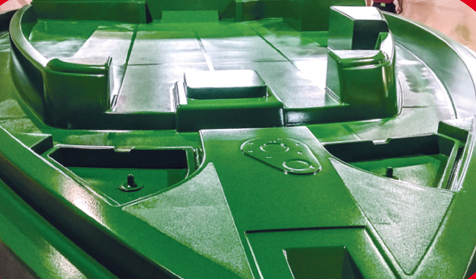Before starting to build the mold, make sure that the pattern has a perfect surface. Since the surface quality of the mold will replicate the pattern, the surface of the pattern should be worked carefully, and the surface coating material should be checked for resistance against styrene. In case pattern and mold should be heated in oven together, the model material should be resistant to at least 50°C.
After making sure that the pattern is properly prepared, apply a mold release agent on the pattern surface. Then apply gel coat in several thin passes in order to avoid air entrapment in the gel coat film. Total thickness of the gel coat film must be between 600-800 microns. It is recommended to use specially formulated BRE 390 mold making gel coat. Keep initiator levels between 1 – 2.5% depending on workshop temperature.
After gel coat is cured, begin lamination. For lamination use BRE 390, zero-shrink mold making resin. The instructions below are valid for building a mold using BRE 910.
As the first layer of lamination, use glass veil followed by preferably a low gramage chopped strand mat. For excellent result, Owens Corning 225 gr / m2 M113 fiber is recommended, which helps minimize fiber print-through. After this step, keep laminating 4-5 layers of 450gr/m2 chopped strand mat at one go. It is of great importance that 4-5 layers are applied at once and if a thicker laminate is required another 4-5 layers should be applied at once. The lamination temperature should reach 50-60°C to prevent any shrinkage. The color of the laminate will change from brownish to white when curing is complete. Color change is an indicator of thorough cure.
Woven fibers cause non-homogenous resin-fiber distribution, which may result in deformation of the mold. Therefore, it is recommended to use only chopped strand mat for mold making. Another point of attention is to avoid accumulation of resin in the lower parts of the mold. Resin rich sections in these areas, may cause deformation due to high exotherm as well as cracks and low mechanical strength. In order to avoid these potential problems, a mold making resin must be thixotropic.
The mold must be supported and reinforced with metal profiles to reduce tension and stress on joint parts. The metal profiles should be assembled in the corners rather than along the mold and should be with two layers of 450 g/m2 chopped strand mat.
The choice of mold release agents for the mold break-in is very important. It is recommended to apply 4-5 layers of mold release wax followed by PVA to avoid possible sticking problems.

